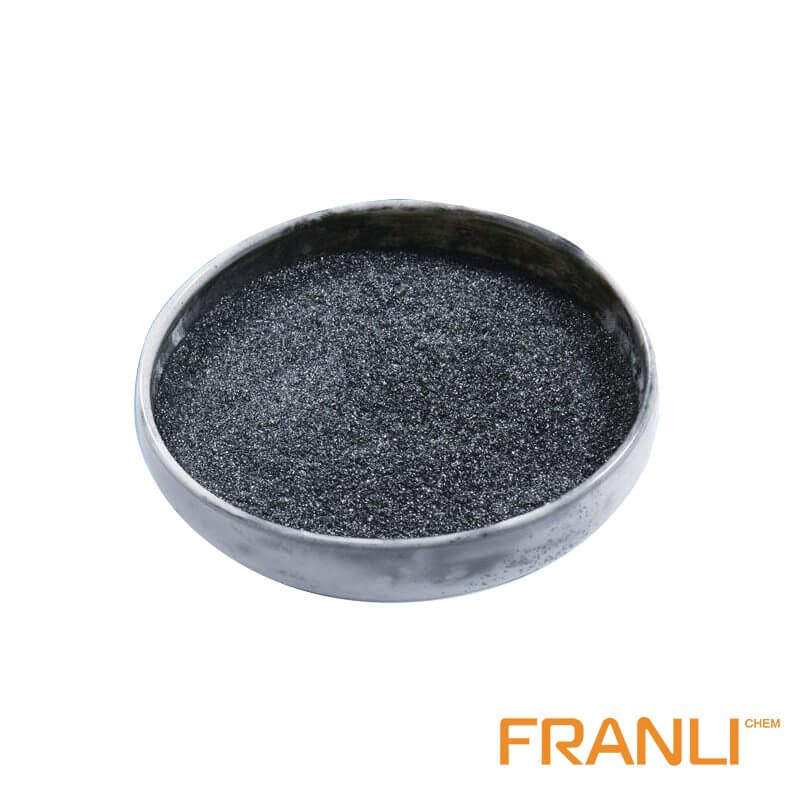

Carbon Graphite
Size
0.01mm
Carbon Content
99%min
Package
25kg small bags into ton bags or ton bags
Features
Good thermal and electrical conductivity, grey-black opaque solid
Application
For mechanical seals, battery manufacturing, anti-corrosion products, carbon graphite electrodes, etc.
Carbon graphite can be used to produce refractory materials, conductive materials, wear-resistant materials, lubricants, high-temperature sealing materials, corrosion-resistant materials, thermal insulation materials, adsorption materials, friction materials and radiation protection materials, etc. These materials are widely used in electromechanical brush and seal etc.
Request a quoteCarbon graphite is commonly used in the mechanical seal industry, but the Franli plant found conductivity in other industries as well. Carbon graphite conducts electricity because the sheet crystal contains a large number of free electrons inside. The outermost layer of the carbon atom has 4 electrons, and only 3 electrons are shared when forming a graphite six-membered ring, and the extra free electron moves in a directional direction under the action of the applied electric field, thereby conducting electricity. Heat conduction is due to the transfer of energy (mainly kinetic energy) between the free electrons of carbon atoms.
Application of carbon graphite conductivity
Carbon graphite can be suitable for the following industries.
(1) Carbon graphite in pencil: carbon graphite is made as a pencil lead as a conductor, when the pencil is in the writing process, due to the friction between the lead and the paper will peel off the tiny carbon atoms layer by layer, but the amount of accumulation of these atomic layers on the paper is very small, resulting in a small degree of contact between different carbon atomic layers, it is very likely that a break occurs somewhere, and a very thick handwriting is depicted, so that it is possible to let the electrons pass smoothly and conduct electricity for a short time.
(2) Electrostatic conductive graphite coating: This coating can effectively prevent the occurrence of electrostatic conduction phenomenon, and is used in occasions with high requirements such as fire prevention and explosion prevention. For example, the inner and outer walls of oil storage and oil transmission equipment such as oil storage tanks, oil pipelines, oil tankers and other industries in petroleum, chemical industry, railway, transportation and other industries to avoid the problem of fire accidents caused by static electricity caused by charge accumulation.
(3) Carbon graphite battery: its charging speed is 60 times faster than the best lithium-ion battery. Both high temperature and cold resistance, will not cause battery injury due to high or low temperature, cycle charge and discharge, the capacity is more than 3 times the capacity of the best lithium battery, more than 10 times that of lead-acid batteries.
(4) Carbon graphite electrode paste: The raw materials of carbon graphite electrode paste mainly include modified asphalt, carbon graphite crushing, electric forging anthracite coal, and petroleum coke after forging. Small resistivity, which can reduce the loss of electrical energy when the current passes through the electrode; The coefficient of thermal expansion is small, and the internal stress caused by the sudden temperature change will cause the electrode to produce small cracks and increase the resistance; The porosity is small, the contact area with oxygen is small, so that the electrode in the heating state oxidizes slowly, and because the electrode strength and conductivity increase, the resistance becomes smaller and the electrical loss becomes less; High mechanical strength.

Principle of carbon graphite conduction
The ability of Carbon graphite conduction is mainly related to 2 factors.
(1) Conductivity depends on the number of free electrons. Thermal conductivity, on the other hand, depends on how vigorously the free electrons move. The electrons inside the carbon graphite molecules have been moving irregularly, and when there is an external temperature gradient or an electric field is applied, the orientation of the electron motion is approximately the same, thereby conducting electricity and heat. Therefore, graphite has good electrical and thermal conductivity.
(2) The conductivity of the carbon graphite electrode increases with the temperature, and the stronger the conductivity; That is to say, the higher the temperature, the lower the resistivity of the carbon graphite electrode, and the better the conductivity.
The difference between carbon graphite and copper conductivity
(1) Carbon graphite conductivity and copper conductivity is different from metal conduction is non-metallic conductivity and metal conductivity, copper conductivity is metal bond connection, carbon graphite conduction is connected by ionic bonds or covalent bonds, most metals in nature have conductivity, non-metals are mostly insulators, only a few carbon and silicon are conductors.
(2) Theoretically, copper conductivity is stronger than carbon graphite, depending on the resistivity of the material, the lower the resistivity, the better the conductivity.
(3) In the electrodes with wide industrial applications, with the development of technology, graphite electrodes have slowly replaced copper electrodes, and copper for electrodes is not easy to make, and the cost is high, and other characteristics are worse than graphite electrodes.
Graphite is a good conductive material, carbon graphite conductivity is a hundred times higher than the general non-metallic minerals, thermal conductivity exceeds steel, iron, lead and other metal materials, Franli factory can provide high-quality carbon graphite used in various fields, replace some metal materials, can save the cost of consumables in some fields.



